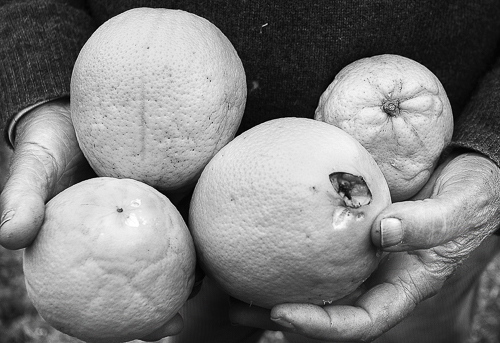Passing through Milis, we noticed the fruit market of the Pinna farm, and decided to have a look. At first, we saw the owner of the farm, Paolo Pinna, talking to some of his customers.
While Maria was presenting our project consisting of photographing the fruit farm and interviewing the owners. Paolo started filling a bag with oranges. Simultaneously, he told us that we had to return early in the evening and after having filled the bag, he handed smilingly the bag to Maria: big, delicious and juicy oranges…a real gift!
Having returned early in the evening, we met the father of Paolo, who willingly showed us their orange grove besides telling us the story of their plantation. Initially, the cultivation of citrus fruits was carried out next to the cultivation of vines. Some 30 years ago, the Pinna family started working with an orange grove which probably had been planted in the 1700s, while the original owner had started tending it in the early 1800s. Initially, they removed all the old trees together with any plant detritus, digging up and flattening the terrain, and introducing artificial irrigation called “moustache” because the water is sprayed out in opposite directions at the same time, one “moustache” for every tree. Presently, the orange grove has an extension of 22 hectares and has to be watered from May to September/October, depending on the dryness of the soil. Since citrus fruits are very sensitive to cold, it’s necessary to protect it against northerly winds. The Pinna family is using a natural windbreaker in order to protect their property. In fact, the orange grove is surrounded by a dense row of old bay trees. We were told that the bay tree has dense, evergreen foliage protecting even the young orange trees rather well, and it doesn’t extract lots of nutrients from the soil, leaving more nutrients for the orange trees.
After having told us about the differences between the various types of oranges grown at the farm (Arrance Washington New, Townson, Novelline, etc.), we were also told about how they are tending the soil in order to have a thriving orange grove. They are practising a semi-organic way of cultivating the orange trees: besides using compost, they are also using a roller to cut weeds together with cutting to pieces branches and leaves lying on the ground after the trees have been pruned. In this way, nutrients which the plants have extracted from the soil, are returned to from which they came. In order to defend the orange trees against a parasite called cochineal, winged insects similar to ladybirds are introduced to the trees. Besides eating the cochineals, it also deposits eggs at the base of the stems of the leaves which is where the parasites usually stay.
Having stopped next to an orange tree in germination, we were able to see the difference between the fruit-bearing buds where the new leaves are enclosing the budding flowers, and the non-fruit-bearing buds which consisted of isolated buds with no leaves.We concluded our visit by tasting various types of mandarins with names like “Vana del Pirene” and “Tardivo di Ciaculli”. Mr. Pinna also kindly gave us a bag full of oranges.
All we could do in return was to thank Mr. Pinna and accept his generous gift, an expression of their culture of hospitality.

